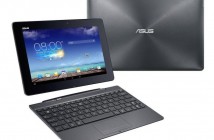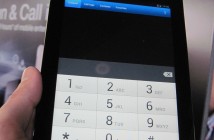Right now, the top two Android tablets on the market that actually offer something unique to the users are the new T-Mobile G-Slate and the HTC Flyer. Sadly, the Xoom and Galaxy Tab failed, but that’s because they were the first to enter the market, not knowing what to expect and what users want – early adopters always have to take the risk in that regard.
LG and HTC on the other hand, waited a bit more, and it seems to have paid off – both of them have announced tablets that look like more refined versions of Motorola and Samsung’s first tries, and they have a much higher chance of being successful on the market. The G-Slate has a pretty much perfect size for a tablet with its 8.9 inch widescreen display, and HTC goes after a completely different niche with their Scribe stylus technology.
Exterior
There’s nothing special about either tablet on the outside: just your standard slate form factor. Of course, the Flyer is smaller with its 7 inch screen, so if you need the most portable device, it would be a better choice than the G-Slate. However, the G-Slate isn’t huge by any means, compared to the iPad and Xoom – 8.9 inches is a perfect size that allows you to work without sacrificing comfort.
Display
The display size may be the biggest difference between these two slates, but the quality of both LCDs is overall pretty high, and both of them have comparable contrast, brightness and color reproduction characteristics. The resolutions differ, with the 7 inch Flyer having 1024×600 pixels (admittedly great for most tasks, including comfortable Web surfing) and the G-Slate featuring a new high resolution of 1280×768, which should make everything look better and fit more on the same screen. The capacitive digitizer works great on both tablets, with the HTC having the unique ability to sense pressure, which makes it THE choice for artists and professionals who need the feature.
Processor, RAM and Graphics
Despite having completely different platforms, both the LG/T-Mobile G-Slate and HTC Flyer have pretty similar performance. The reason for this is that although the NVidia Tegra 2 in the G-Slate has two cores, they run at only 1 GHz each, while the second generation Snapdragon in the Flyer runs at a high 1.5 GHz frequency that puts its performance at the same level (and even higher in most apps, which are still single-threaded at the moment).
Both devices have 1 GB of RAM and comparable graphics adapters (the Adreno 205 and GeForce ULV go toe-to-toe in most performance tests), so the overall performance should be the same, especially considering they run different versions of Android (Honeycomb on G-Slate with better multicore support and Gingerbread on the Flyer, which is perfect for single core devices).
Storage Space
There are also 32 GB in both the G-Slate and the Flyer, however if you need more than that, the latter is your best choice, as it has a micro SD card slot, which can be used to add another 32 GB of memory – why LG couldn’t add it as well (especially when the bigger display is better for movies and other media) is a mystery to me and many other potential buyers.
Other hardware specs
Both tablets share the same specs in most of the secondary hardware features, including Wifi N, Bluetooth 3.0, DLNA, gyroscope and advanced accelerometers (with gesture support), magnetometer, GPS and more. One of the main features of the G-Slate is its dual camera array on the back, which can take 3D photos and film 720p HD video. But this is nothing more than a gimmick, given that you’ll need special glasses to view said recordings. The G-Slate also records 1080p video in 2D, while the Flyer only supports 720p – not that there’s a big difference, given the size of the sensor (plus LGs cameras are known for their soft focus and under-saturated colors).
Software
Software-wise, many people would of course prefer the G-Slate, with the new Android 3.0 Honeycomb OS – a marvelous system, indeed. The high display resolution only helps it, but the lack of good apps on the market is a bit daunting. Android 2.3.3 comes with the Flyer from the factory, and coupled with the Scribe technology, it can actually trump the overall beauty of Honeycomb – with a simple touch, you can take a text, audio or video note, draw something or write it down using the stylus, and the pressure sensitivity and palm detection features work pretty well, so if you need them, the Flyer is the only tablet on the market you can get.
Conclusion
Both the HTC Flyer and T-Mobile G-Slate are very similar, however they’re targeted at different niches: the first one is meant for art students and professionals who need stylus support and need to take notes/drawings in the field, while the second device is more of a universal Android tablet that is meant to compete with the iPad for consumers – if the price is lower, I would actually get the Flyer, but if they’re equally priced, the decision could be more difficult.



